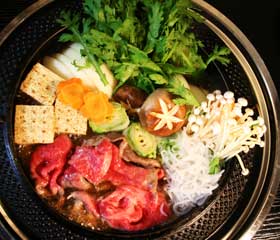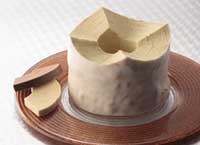|
KOBE, CULINARY GATEWAY TO THE WEST
Cakes and Bread Spread to Japan via Vibrant Port City
(February 5, 2008) |
|
January 1, 2008 marked the 140th anniversary of the opening of Kobe's port to the outside world. Kobe today is a cosmopolitan city boasting both the natural beauty of the Rokko mountains and the refined scenery of its portside district. Since Kobe's port opened in 1868, the city has assimilated many aspects of foreign culture, lending it a charm all its own. The original foreign settlement of Kobe had been a desolate area before foreign merchants began living there. From its humble beginnings, Kobe has transformed into a modern and vibrant metropolis of 1.5 million inhabitants with a diverse food culture featuring Western dishes and confectionery and Chinese cuisine. The Birthplace of Japanese Beef Although the traditional way to enjoy Kobe Beef is as a steak, the most common way for families in Japan to eat the delicacy is in sukiyaki. This is especially the case in the Kansai region of Japan, where thin slices of the meat are first cooked in a cast-iron pan, then vegetables including Chinese cabbage and white leeks are added. The dish is flavored with sugar and soy sauce. Sake is sometimes also added to give the dish a fuller flavor. Sukiyaki is a particular favorite during the winter months, when it is great for warming up on cold days. Another mouth-watering dish in which Kobe beef is often used is shabushabu. To make shabushabu, a kelp-based broth is brought to a boil in a pot; thinly-sliced beef is then briefly dunked in the hot broth. The beef is then eaten after being dipped in ponzu sauce (a mixture of citrus juices, vinegar, and soy sauce). A Taste of the West Freundlieb, a German bakery and restaurant that opened for business in 1924, is another must-try in Kobe. It is so well known that when you mention "bread" in Kobe, many Kobe residents immediately think of Freundlieb. If you should visit Freundlieb, be sure to try the highly recommended homemade roast beef sandwiches in the historic renovated church that houses the restaurant. Around the same time that Freundlieb was established, a small cafe run by Juchheim opened its doors in Kobe. Juchheim today is a company known nationwide for its Baumkuchen (a vertically layered German cake). Also based in Kobe are the renowned chocolate makers Goncharoff and Morozoff, which were originally established in Kobe by two Russian exiles, Feodor Morozoff and Makar Goncharoff, the latter of whom had been a confectioner for the Romanov dynasty before fleeing the Russian Revolution. No visitor to Kobe should leave without sampling Morozoff's flan with its rich, thick custard. |
Copyright (C)2008 Web Japan. Edited by Japan Echo Inc. based on domestic Japanese news sources. Articles presented here are offered for reference purposes and do not necessarily represent the policy or views of the Japanese Government.







